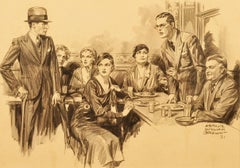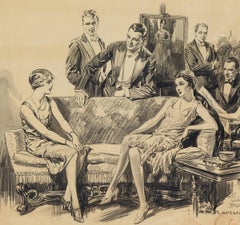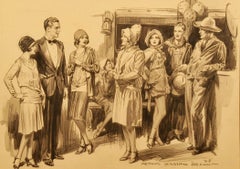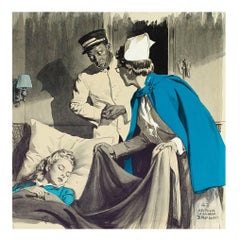William Arthur Brown
American, 1881-1966
" "Brownie," as his artist friends called him, epitomizes the rule that "90% of life is just showing up." A Canadian school dropout, he worked on a steamer, sketching in his spare time (he sold these to newspapers). Saving his earnings, he enrolled at the Art Student’s League and studied under Walter Appleton Clark, F W DuMond, and FR Gruger. Brownie went along when a friend got a job from the Saturday Evening Post to cover a circus. The Post liked the article AND Brown's circus drawings. They bought them, a relationship between publisher and artist that lasted 40 years. Brown's pencils appeared in most Post issues from the teens on. He concentrated on story art (no covers) for Collier's, College Humor, Redbook, and Cosmopolitan. He also contributed posters for the WWI effort and book art for books (The Magnificent Ambersons, Alice Adams, The Fortune Hunter, The Upper Crust, Messer Marco Polo, The Midlanders, The Lady Evelyn). The vast majority of Brown's work was in pencil, though ink and color wash began appearing in his kit from the early 30s." -American Art Archives.com.to
1
3
3
1
Overall Width
to
Overall Height
to
7
1
3
1
1
5
2
7
5
5
4
1
1
1
1
1
1
1
1
1
1
5
3
2
2
2
7
8,230
2,806
1,652
1,317
7
Artist: William Arthur Brown
Original "For Your Boy, YMCA, vintage WW1 1918 poster
By Arthur William Brown
Located in Spokane, WA
Original. YMCA for Your Boy. Acid-free original vintage poster in excellent condition with archival linen backing, ready to frame. Certificate o...
Category
1910s American Realist William Arthur Brown
Materials
Lithograph
$620 Sale Price
20% Off
Sitting Around the Table
By Arthur William Brown
Located in Fort Washington, PA
Date: 1931
Medium: Oil on Canvas
Dimensions: 16.00" x 22.00"
Signature: Signed Lower Right
Interior setting with people seated around a table.
Category
1930s William Arthur Brown
Materials
Canvas, Oil
Saturday Evening Post story, 1920s Parlor Scene
By Arthur William Brown
Located in Fort Washington, PA
Date: 1920
Medium: Charcoal and Watercolor on Board
Dimensions: 16.00" x 19.00"
Signature: Signed and Inscription Lower Right Corner
1920s parlor scene. ...
Category
1920s William Arthur Brown
Materials
Charcoal, Watercolor, Board
"Winnie and the Copperhead” Saturday Evening Post Illustration
By Arthur William Brown
Located in Fort Washington, PA
Published in the Saturday Evening Post dated 11-18 1922 page 107 for the "Winnie and the Copperhead” story written by Bertram Atkey
Signed and dated lower left
Arthur William Brown...
Category
1920s Other Art Style William Arthur Brown
Materials
Charcoal
(Untitled)
By Arthur William Brown
Located in Fort Washington, PA
Date: 1928
Medium: Oil on Canvas
Dimensions: 16.00" x 22.00"
Signature: Signed Lower Right
Interior setting with people standing around.
Category
1920s William Arthur Brown
Materials
Canvas, Oil
The Best People
By Arthur William Brown
Located in Fort Washington, PA
Illustration for story called 'The Best People', published in Redbook magazine, January, 1943, with their job stamp on verso.
Signed and dated lower right.
Arthur William Brown...
Category
1940s Other Art Style William Arthur Brown
Materials
Board, Gouache, Watercolor
Women and Baby
By Arthur William Brown
Located in Fort Washington, PA
Women and Baby
Signed upper right
Arthur William Brown had one of the longest and most prolific careers of any American illustrator. Born in...
Category
20th Century Other Art Style William Arthur Brown
Materials
Watercolor
Related Items
Untitled II
By Erez Yardeni
Located in London, GB
'Untitled II' abstract composition, mixed media on soft board, Japanese ink, oil, pencil and gouache by Erez Yardeni (2018). There is so much energy in th...
Category
2010s Abstract William Arthur Brown
Materials
Ink, Oil, Gouache, Board, Pencil
Untitled
By Erez Yardeni
Located in London, GB
'Untitled' abstract composition, mixed media on soft board, Japanese ink, oil, pencil and gouache by Erez Yardeni (2018). Beautifully balanced, stunningly...
Category
2010s Abstract William Arthur Brown
Materials
Ink, Oil, Gouache, Board, Pencil
Dinosaur Me & Baby
By Erez Yardeni
Located in London, GB
'Dinosaur Me & Baby' abstract composition, mixed media on soft board, Japanese ink, oil, pencil and gouache by Erez Yardeni (2018). The scribblings of a c...
Category
2010s Abstract William Arthur Brown
Materials
Ink, Oil, Gouache, Board, Pencil
Mid Century California Mission Landscape
Located in Soquel, CA
Beautiful mid century landscape of a historic California mission, highlighting its iconic architectural details such as a columned arches, white was...
Category
Mid-20th Century American Impressionist William Arthur Brown
Materials
Paper, Gouache, Cardboard
Mid Century French Pencil Sketch Fashionable Sketches of Figures and Accessories
By Josine Vignon
Located in Cirencester, Gloucestershire
Mid Century French Portrait
Josine Vignon (French 1922-2022)
Medium: Pencil/ charcoal /watercolour on artists paper, double sided
Size: 9.5 height) x 6.25 (width)
Stamped Verso
Con...
Category
Mid-20th Century Post-Impressionist William Arthur Brown
Materials
Charcoal, Pencil, Watercolor
$107 Sale Price
30% Off
H 9.5 in W 6.25 in D 1 in
Mothu et Doria: A 19th C. Lithograph from Les Maitres de l'Affiche by Steinlen
By Théophile Alexandre Steinlen
Located in Alamo, CA
This is a framed 19th century color lithograph entitled "Mothu et Doria" created by Theophile Alexandre Steinlen and published between 1896 and 1899 in Paris, France by Jules Cheret in his famous series of miniature colored stone lithographs of popular Belle Epoch posters...
Category
Late 19th Century William Arthur Brown
Materials
Lithograph
$1,375
H 22.25 in W 18.125 in D 0.75 in
GARDEN ROMANCE Signed Lithograph, Black Couple, Collage Portrait Lovers, Flowers
By James Denmark
Located in Union City, NJ
GARDEN ROMANCE by the artist James Denmark is an original hand drawn, limited edition lithograph(not a photo reproduction or digital print) printed on archival Somerset paper using traditional hand lithography techniques. GARDEN ROMANCE is one of Denmark's expressive, colorful collage compositions of everyday African American life - a lovely flower garden scene featuring a romantic black couple, the woman seated amid the blossoming plants wearing a green and yellow paisley print dress and head wrap; her standing male companion with flower in hand, dressed in blue denim jeans, and pastel color patchwork print shirt. Vivid coloration, watercolor patterns, and collage effect textures captivate the eye with visual variety in a striking palette of blues, greens, white, red, orange, magenta, touches of yellow, lavender and dark black - a fine example of the intricacies of hand lithography!
Print size - 32 x 21.25 in., archival framing, double mat, excellent condition, pencil signed and numbered - Certificate of Authenticity provided
1 / 15 H.C. by James Denmark, publisher's chop embossed lower left corner
Edition size - 250, plus proofs
Year published - 1996
Printer - JK Fine Art Editions Co. NJ
Publisher - Mojo Portfolio...
Category
1990s Contemporary William Arthur Brown
Materials
Lithograph
"Village in Mexico" Post-Impressionist Town Scene Oil Painting on Canvas Framed
By Jacques Zucker
Located in New York, NY
This painting depicts an village scene of people gathering about to have lunch in a Mexican town street. The fun details are what make this painting so attractive and desirable; ther...
Category
20th Century Post-Impressionist William Arthur Brown
Materials
Canvas, Oil
$4,500
H 32.5 in W 25 in D 3 in
GARDEN ROMANCE Signed Lithograph, Black Couple Portrait, Lovers, Flower Garden
By James Denmark
Located in Union City, NJ
GARDEN ROMANCE by the artist James Denmark is an original hand drawn, limited edition lithograph(not a photo reproduction or digital print) printed on archival Somerset paper using t...
Category
1990s Contemporary William Arthur Brown
Materials
Lithograph
Adolf Dehn, Haitian Scene A, signed painting, Associated American Artists, 1950s
By Adolf Arthur Dehn
Located in New York, NY
Adolf Arthur Dehn
Haitian Scene A, ca. 1951
Watercolor gouache on board
Signed on the front
Frame included: held in vintage modern frame
Measurements:
Framed:
11 inches vertical by 13 inches horizontal by .75
Painting
4.5 inches by 6 inches
Watercolor gouache, hand signed; framed with AAA Gallery label verso
Signed on the front bearing the original label on the verso of Dehn's longtime gallery, the prestigious Associated American Artists Gallery, New York City.
Provenance
Associated American Artists
Frame included: held in vintage frame with original label as provenance
Dehn, an influential artist and teacher (and author of the definitive textbook of his era on watercolor painting) joined Associated American Artists gallery in 1941. Although this painting is undated, it is likely circa early 1950s, as in 1951 Dehn won a Guggenheim Fellowship, which enabled him to travel to Haiti -- the subject of this work. It was part of a series inspired by Dehn's visit to Haiti.
Dehn, an influential artist and teacher (and author of the definitive textbook of his era on watercolor painting) joined Associated American Artists gallery in 1941. Although this painting is undated, it is likely circa early 1950s, as in 1951 Dehn won a Guggenheim Fellowship, which enabled him to travel to Haiti.
ADLOF DEHN
Adolf Dehn, American Watercolorist and Printmaker, 1895-1968
Adolf Dehn was an artist who achieved extraordinary artistic heights, but in a very particular artistic sphere - not so much in oil painting as in watercolor and lithography. Long recognized as a master by serious print collectors, he is gradually gaining recognition as a notable and influential figure in the overall history of American art.
In the 19th century, with the invention of the rotary press, which made possible enormous print runs, and the development of the popular, mass-market magazines, newspaper and magazine illustration developed into an artistic realm of its own, often surprisingly divorced from the world of museums and art exhibitions, and today remains surprisingly overlooked by most art historians. Dehn in many regards was an outgrowth of this world, although in an unusual way, since as a young man he produced most of his illustrative work not for popular magazines, such as The Saturday Evening Post, but rather for radical journals, such as The Masses or The Liberator, or artistic "little magazines" such as The Dial. This background established the foundation of his outlook, and led later to his unique and distinctive contribution to American graphic art.
If there’s a distinctive quality to his work, it was his skill in introducing unusual tonal and textural effects into his work, particularly in printmaking but also in watercolor. Jackson Pollock seems to have been one of many notable artists who were influenced by his techniques.
Early Years, 1895 - 1922
For an artist largely remembered for scenes of Vienna and Paris, Adolf Dehn’s background was a surprising one. Born in Waterville, Minnesota, on November 22, 1895, Dehn was the descendent of farmers who had emigrated from Germany and homesteaded in the region, initially in a one-room log cabin with a dirt floor. Adolf’s father, Arthur Clark Dehn, was a hunter and trapper who took pride that he had no boss but himself, and who had little use for art. Indeed, during Adolf’s boyhood the walls of his bedroom and the space under his bed were filled with the pelts of mink, muskrats and skunks that his father had killed, skinned and stretched on drying boards. It was Adolf’s mother, Emilie Haas Dehn, a faithful member of the German Lutheran Evangelical Church, who encouraged his interest in art, which became apparent early in childhood. Both parents were ardent socialists, and supporters of Eugene Debs...
Category
1950s Modern William Arthur Brown
Materials
Watercolor, Gouache, Board
$2,500
H 11 in W 13 in D 0.75 in
"On the Stairwell" Impressionist French Street Scene Oil Painting on Canvas
By Jacques Zucker
Located in New York, NY
This painting depicts a landscape scene of a town scene of figures on the stairwell. The attractive perspective is what makes this painting so interesting and desirable; there is a s...
Category
20th Century Post-Impressionist William Arthur Brown
Materials
Canvas, Oil
$3,800
H 20.25 in W 17 in D 2 in
Cowboy in the Canyon, Small Contemporary Multicolor Abstract Figural Landscape
By Tiffanie Mang
Located in Soquel, CA
Small-scale yet bold multi-colored abstracted figurative landscape of a horse rider in a canyon (a study after Edgar Payne’s works) by Tiffanie Mang (Ameri...
Category
2010s American Impressionist William Arthur Brown
Materials
Gouache, Cardboard
$700 Sale Price
20% Off
H 9.5 in W 9.5 in D 0.13 in
William Arthur Brown art for sale on 1stDibs.
Find a wide variety of authentic William Arthur Brown available for sale on 1stDibs. You can also browse by medium to find art by William Arthur Brown in paint, watercolor, board and more. Not every interior allows for large William Arthur Brown, so small editions measuring 12 inches across are available. Customers who are interested in this artist might also find the work of Thelma Terrell, Robert Andrew Parker, and Walter G. Ratterman. William Arthur Brown prices can differ depending upon medium, time period and other attributes. On 1stDibs, the price for these items starts at $1,650 and tops out at $3,400, while the average work can sell for $2,758.







